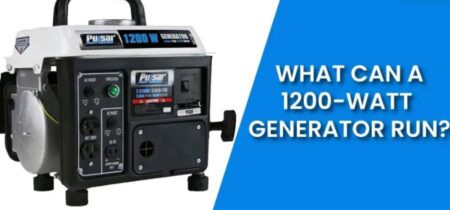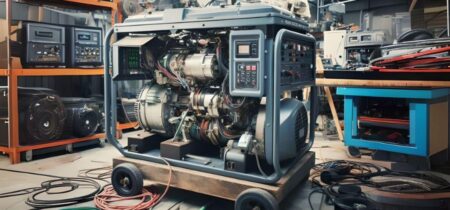
In the era of power generation, Generac generators stand out for their reliability and performance. Central to their functionality is the battery— a main component that kickstarts the system. These generators use a 12V lead-acid battery similar to the ones found in vehicles, with Generac recommending a 26-R wet-cell battery for its air-cooled standby models. The battery often demands replacement every 3 years.
The generator model influences the selection of the right battery which makes it essential to consult the manual before purchasing a new one. Most standard car batteries are compatible but understand that portable generators with electric start mechanisms will have a replaceable, rechargeable battery, specified in the generator’s user manual. Also, the battery size is mostly determined to provide 75% of the generator’s wattage to ensure operation.
How to Determine the Power Requirements of Your Generac Generator and the Battery?
To determine the power requirements and the appropriate battery for your Generac generator, you should consider several factors:
Generator’s Wattage: The battery size required for a Generac generator is dependent on the wattage of the generator itself. Many generators that are made by Generac have a 12-V battery. A bigger battery might be required if your producer has a greater watt load ranking.
Battery Specifications: Air-cooled units (except for the Power Pact model) may need a Group 26 R 540 CCA (Cold Cranking Amps) or 35 AGM 650 CCA capacity battery. AGM 35 works best at low temperatures.
Manual and Manufacturer’s Recommendations: You should always consult a manufacturer’s manual to be directed toward the appropriate battery size and type. Always, refer to a manufacturer’s manual to be directed towards the correct battery size and type. This manual gives you the specifics of the battery’s size and type that fits to work with your engine.
Load Requirements: The proper size of a battery should depend upon the load it is supposed to carry for your generator including both watt and ampere values. However, this information is present in the manager’s manual and a manufacturer can provide this.
Climate Conditions: Your local climate may affect how the battery works out. You may have to size your battery bigger for it to function efficiently under extremely hot weather conditions.
Battery Capacity and Usage: Select one with more capacity than the least amount required for the most dependable operation, particularly in harsh weather conditions. Required capacity depends upon usage and ambient temperature.
Take, for example, a Generac 2-22KW generating system that needs a battery of a minimum of 525 CCA and in group size of 26R. The voltage shall be 12V with not less than 100 minutes of run time reserved.
How to Compare the Different Categories and Types of Batteries for Generac Generators?
When selecting a battery for a Generac generator, it’s important to understand the various options available and their respective features. Here’s a comprehensive comparison:
Flooded Lead-Acid Batteries:
- Common Use: Widely used in Generac generators.
- Pros: Affordable and easily available.
- Cons: Require regular maintenance such as adding water and checking electrolyte levels.
Sealed AGM Batteries (Absorbent Glass Mat):
- Common Use: Compatible with Generac generators.
- Pros: Less maintenance, more durable, better performance in extreme temperatures.
- Cons: More expensive than flooded lead-acid batteries.
Lithium-Ion Batteries:
- Common Use: Increasingly popular for Generac generators.
- Pros: Lightweight, high energy density, longer run times, faster recharging.
- Cons: More expensive compared to lead-acid batteries.
Gel Batteries:
- Common Use: Compatible with Generac generators.
- Pros: Similar to AGM but uses gel electrolyte, less prone to leakage and more durable.
- Cons: Pricing and availability may vary.
Deep Cycle Batteries:
- Common Use: Ideal for Generac generators requiring extended run times.
- Pros: Provides consistent power over a long period.
- Cons: Can be either flooded or sealed; varies in size and capacity.
Neptune 12V 9Ah NT-1290 SLA Battery:
- Specifics: Uses AGM technology, compatible with various Generac generator types.
- Pros: Long battery life, high-standard separators, valve-regulated lead-acid.
- Cons: Specific to certain generator types and models.
Standard Lead-Acid Batteries:
- Specifics: Used in most air-cooled units (Group 26R 540 CCA) or 35 AGM 650 CCA for cold temperatures.
- Pros: Standard option, well-suited for most models.
- Cons: May not perform as well in extreme conditions.
Every battery type for the generator has some distinct advantages and disadvantages and the ideal choice depends on several factors: Generator model, environmental conditions, preferred maintenance, and budget. For precise compatibility and sizing details of your generator, the user manual or product summary available in Generac’s website is your reference point. Just keep this in mind, using the wrong
battery for your specific generator model may affect its performance and overall life span.
How to Install, Maintain, and Replace Your Generac Generator Battery?
Installation
Safety First: Ensure the generator is turned off and disconnected from power sources. Wear protective gear like safety goggles and gloves.
Prepare Tools: You’ll need a socket set for removing and connecting battery cables.
Locate the Battery: Find the battery compartment, usually near the engine. It might require removing a cover or panel.
Remove Old Battery: Disconnect the old battery, starting with the negative (black) cable, and then the positive (red) cable. Later on, carefully remove the old battery and dispose of it responsibly.
Install New Battery: Place the new, fully charged battery in the compartment and make sure it’s aligned and secure.
Reconnect Cables: Connect the positive (red) cable to the positive terminal, and then the negative (black) cable to the negative terminal. Tighten the connections securely.
Reset the Generator: Locate and press/flip the reset button or switch on the control panel.
Test the Generator: Start the generator and let it run for a few minutes. Check for proper functioning and any warning lights or error codes. This guidance is a universal statement for most Generac generators. For detailed guidance, consider referring to your generator’s user manual or contacting a
professional.
Maintenance
Installing the Generac generator is easy, but maintenance is the real deal. So let me give you a clear and succinct guide on how you can keep your generator in complete newness:
- Regularly check the battery charge.
- Keep the battery clean, and free from dirt and corrosion.
- Ensure the connections are tight and secure.
- Charge the battery every three months if not used.
- Store the battery in a cool, dry place if not in use.
- Use a battery maintainer for prolonged storage.
- Replace the battery every 3-5 years, or as recommended.
- Regularly run the generator to keep the battery charged.
- Follow the manufacturer’s specific maintenance guidelines.
- Inspect for any signs of damage or wear periodically.
Replacement
● Turn off the generator and disconnect it from the power source.
● Locate the battery compartment, usually at the front or side of the generator.
● Open the compartment to access the battery.
● Disconnect the negative (-) battery cable first, then the positive (+) cable.
● Remove the old battery from the compartment.
● Place the new battery in the compartment.
● Connect the positive (+) battery cable first, then the negative (-) cable.
● Ensure the connections are tight and secure.
● Close the battery compartment.
● Reconnect the generator to the power source and turn it on to test the new
battery.
Conclusion
The choice of a suitable Generac generator requires knowledge about the generator’s wattage, recommended models as well and prevailing conditions in the atmosphere. Ensure that you have proper installation, regular maintenance, and timely replacement for your generator to have optimum performance and a long life span. Always, however, refer to the user manual for specific guidance adapted for your particular generator model.
Frequently Asked Questions
What battery goes in a Generac?
The battery type for a Generac generator depends on the specific model. Generally, Generac generators use 12-volt batteries. For accurate information, check the user manual or contact Generac support with your model number.
Can you use a car battery in a Generac generator?
No, it’s not recommended to use a car battery in a Generac generator. Generac generators are designed for specific battery types and capacities. A car battery might not meet the power requirements, leading to performance issues or damage. It’s best to use the battery type recommended by Generac for optimal performance and safety.
What keeps the battery charged on a Generac generator?
Generac generators typically have a battery charger built into the system. This charger keeps the battery charged while the generator is running. It ensures that the battery is ready to start the generator during a power outage. The battery charger is usually connected to an external power source. When the generator is not in use, this external power maintains the battery’s charge.
How much is a new Generac battery?
The cost of a new Generac PWRcell battery depends on the size and specifications but generally falls within a certain price range. The average total cost for installation, before tax credits, ranges from $12,000 to $20,000.
The starting price for the Generac PWRcell is around $12,435, with the cost increasing for larger battery models. This price typically includes the battery itself, but not additional costs such as installation and labor.
Also, the Generac PWRcell battery has a base price of approximately $10,000. The PWRcell is scalable, meaning it is available in several different sizes to meet varying energy needs.









